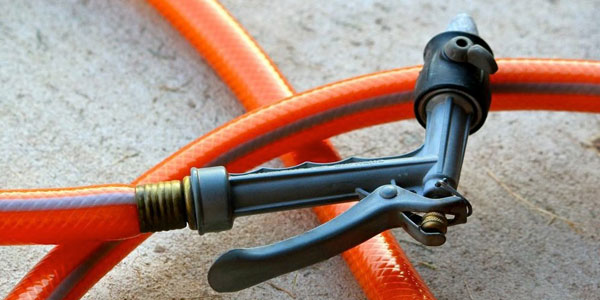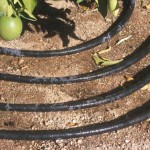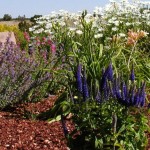
Here in the Southwest, most people use more water outdoors during the hotter months. Efficient irrigation practices, practical planting and water-wise landscaping can make a big difference. We have helpful information on how to keep your landscape looking beautiful with less water.
“Your Choice” Outdoor Water Restrictions
Under city water rules, you may select which days you want to water but you cannot water between 10 a.m. and 6 p.m between May 1 and October 31, and it’s recommended that you don’t water more than three times per week. Remember to adjust water frequency and duration according to weather and time of year.
Summer watering accounts for more than 40 percent of our water use. Conserving water during the summer will save you money on your water bill and help the city reduce overall water usage.
You can save water even during the hottest months by following the city rules.
As Easy as 1, 2, 3
1 – Water no more than once on the weekend.
2 – Water no more than twice more during the week.
3 – Water no more than three times per week total.
In the Yard
- Use drip-irrigation systems for bedded plants, trees and shrubs, or turn the flat, green soaking hoses upside down so the holes are on the bottom. This will help prevent evaporation.
- Choose a smart or weather based irrigation controller. An irrigation system can be set to water the lawn for a specified amount of time. This saves you time and waters the lawn evenly. If you don’t have controller, set a kitchen timer. A lot of water can be wasted if you forget to turn off your irrigation system. Outdoor faucets can flow at rates as high as 300 gallons per hour.
- Forget about watering the streets, sidewalks or driveways. They will never grow a thing.
- Add mulch, it will help your plants stay wet longer and a mulch, bark, or rock area at least 8 inches wide next to sidewalks and curbs will help eliminate water waste.
- Use a soil probe to test soil moisture. Water only when a soil probe shows dry soil or a screwdriver is difficult to push into the soil.
- Step on the grass; if it springs back up when you move your foot, it does not need water.
- Avoid watering when it is windy. Wind causes water to evaporate quickly and blows water onto areas where it is not needed.
- Water without waste. Interrupt watering when puddles or runoff occur to allow the water to penetrate into the soil then resume irrigation.
- Keep landscapes free of weeds. Weeds are water thieves and will rob your plants of water and nutrients. Spot spray or remove weeds as they appear.
- Accept a less-than-lush lawn. Grass will naturally go dormant during periods of drought but will readily regenerate when water becomes available. Reduce traffic on stressed turf areas if possible.
- Use low-water-use turf. Many chain stores in Santa Fe sell Kentucky Blue Grass seed but planting it is against the law in Santa Fe. The seed is cheaper but a Kentucky Blue Grass lawn will cost you in the long run through high water bills and a City fine.
- Learn to accept turf grasses with low water needs, such as buffalo grass.
- Use a broom to clean the driveway and sidewalk. Sweeping the driveway and sidewalk will get them clean enough without wasting gallons of water.
- Cover your swimming pool or spa. It’s the law and covering a swimming pool will help reduce evaporation. An average sized pool can use about 1,000 gallons of water per month if left uncovered. A pool cover can cut the loss by up to 90 percent.
- Use shut-off nozzles on hoses. Shut-off nozzles completely turn off the water when you are not using it. City rules require them.
Xeriscape Your Garden
Plant drought resistant trees and plants. These plants can be very attractive and can survive drought better than turf. Rocks, gravel, benches, and deck areas can all be used to creatively decorate the yard. A demonstration garden at the Water Division, 801 West San Mateo, consisting of desert rose, shades of purple, high desertscape, and xeriscape, uses efficient irrigation and a weather based controller. It features water harvesting techniques, including a solar-powered recycled water feature. Call 505-955-4225 or stop by the office to arrange a tour and get tips.
Harvest Your Rainwater
A thousand square feet of roof or pavement can collect about 600 gallons of water from 1 inch of rain.
Rooftops or any sloping surface such as a driveway are prime “catchment” areas for rainwater. Store the collected water in a cistern, and siphon it off to water your garden or wash your car. Locate your cistern close to wherever you plan to use the water. To filter out leaves and debris, install a removable screen at the entrance to the cistern. The City offers rainwater harvesting rebates for rain barrels and cisterns. Terms and conditions apply.
Want to know more? Check out these quick links.
- Plant Native
- Irrigation Basics
- Low Volume Irrigation Design and Installation Guide
- A Waterwise Guide to Trees
- New Mexico Gray Water Guide (We recommend printing this Landscape)
- The Enchanted Xeriscape
- Xeriscape 101
- Xeriscaping , The Complete How To Guide
- High Country Gardens
- New Mexico Plant List
- USDA Plant Database
- North American Native Plant Society
